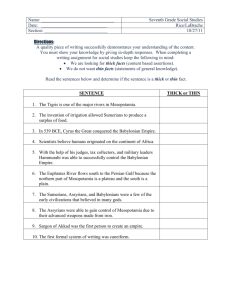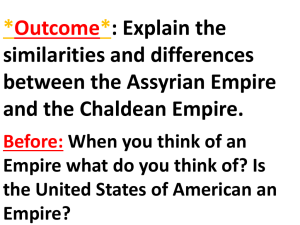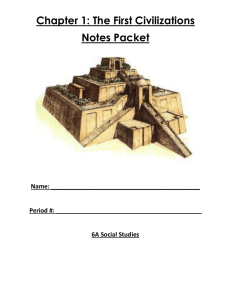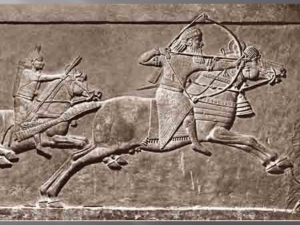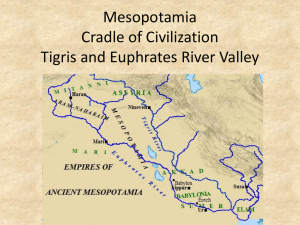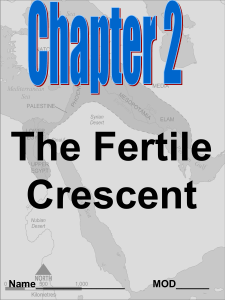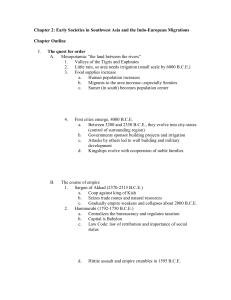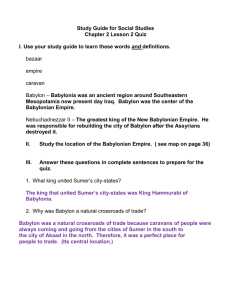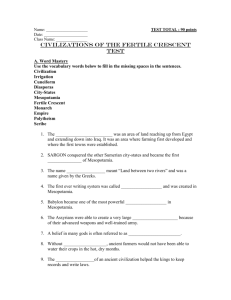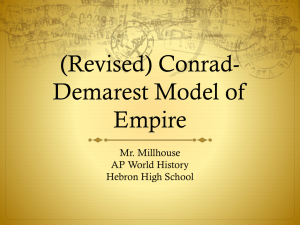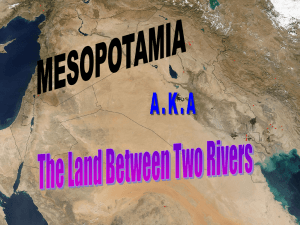File
advertisement
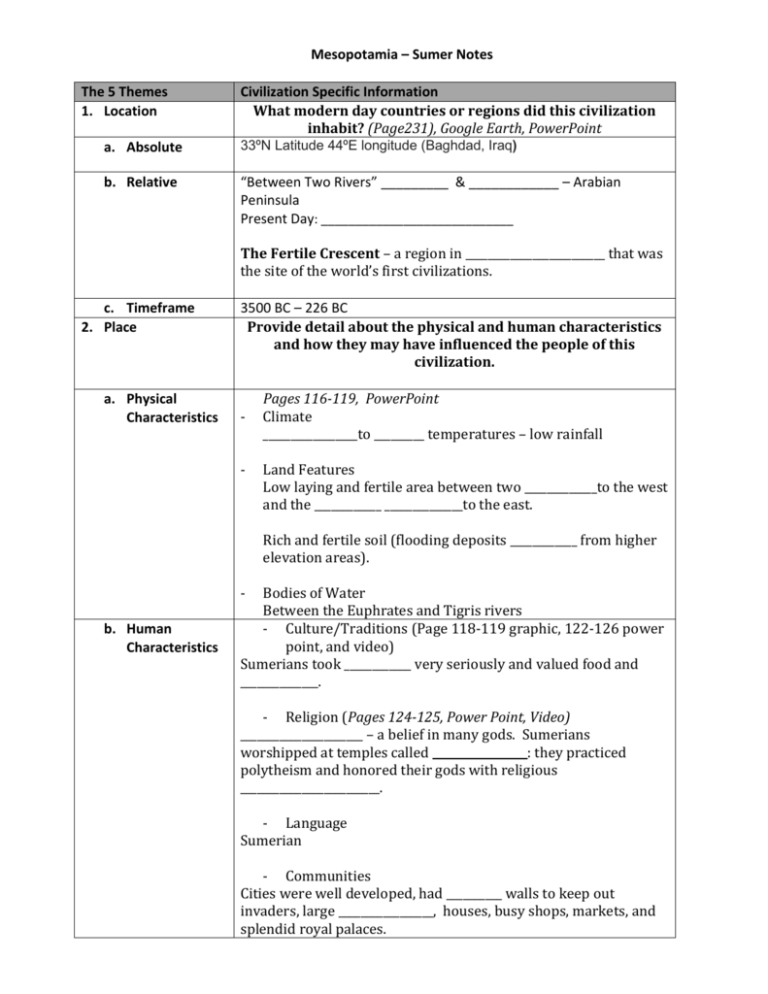
Mesopotamia – Sumer Notes The 5 Themes 1. Location Civilization Specific Information What modern day countries or regions did this civilization inhabit? (Page231), Google Earth, PowerPoint a. Absolute 33ºN Latitude 44ºE longitude (Baghdad, Iraq) b. Relative “Between Two Rivers” _________ & ____________ – Arabian Peninsula Present Day: ____________________________ The Fertile Crescent – a region in _________________________ that was the site of the world’s first civilizations. c. Timeframe 2. Place a. Physical Characteristics 3500 BC – 226 BC Provide detail about the physical and human characteristics and how they may have influenced the people of this civilization. - Pages 116-119, PowerPoint Climate _________________to _________ temperatures – low rainfall Land Features Low laying and fertile area between two _____________to the west and the ____________ ______________to the east. Rich and fertile soil (flooding deposits ____________ from higher elevation areas). b. Human Characteristics Bodies of Water Between the Euphrates and Tigris rivers - Culture/Traditions (Page 118-119 graphic, 122-126 power point, and video) Sumerians took ____________ very seriously and valued food and ______________. - Religion (Pages 124-125, Power Point, Video) ______________________ – a belief in many gods. Sumerians worshipped at temples called _________________: they practiced polytheism and honored their gods with religious _________________________. - Language Sumerian - Communities Cities were well developed, had __________ walls to keep out invaders, large _________________, houses, busy shops, markets, and splendid royal palaces. City states shared culture, language, religion. - Government/Political Structure Each Sumerian was its own politically independent __________ _________; each had its own ____________, its own ___________, and its own _________________________. - Buildings and landmarks (pages 124-125 graphic¸ page 126, powerpoint) ______________ to the ______________(ziggurat). ______________________ palace – built for his wife who hated the dry landscape of Mesopotamia. - Daily Life Cities with scribes, farmers, traders, artists, musicians, merchants, beggars. Social Structure (http://www.ducksters.com/history/mesopotamia/daily_life_in_mesopotamia.php) At the top of society was the ___________ and his ___________. The priests were considered near the top as well. The rest of the upper class was made up of the wealthy such as high level _________________and _______________. Below the upper class was a small ____________ class made up of craftsman, merchants, and civil servants. They could make a decent living and could work hard to try and move up in class. The lower class was made up of _______________ and _____________. These people lived a harder life, but could still work their way up with hard work. At the bottom were the _____________. Slaves were owned by the king or bought and sold among the upper class. Slaves were usually people who were captured in __________________. Clothing Clothing was typically made from ______________ or wool. The men wore kilt-like ____________ and the women wore longer dresses. They enjoyed wearing __________________, especially rings. The women braided their long hair, while the men had long hair and beards. Both men and women wore _______________. 3. Region Babylonian Empire Page 116 A ____________________ of trade due to its central location in Mesopotamia. Roads were built throughout the empire. ________________, or groups of travelers stopped in Babylon on their way between Sumer and Assyria. In the city’s _________________ or markets shoppers could buy cotton cloth from India and spices from Egypt. _____________ conquered large amounts of land Gathered great wealth through ___________________. _____________________- created the Babylonian Empire in 1787 BC Assyrian Empire After defeating the Assyrians, the Chaldeans rebuilt and fortified the city of _________________________. Page 44 The Assyrians built a large empire by ________________first. The Assyrians were skilled ______________ with advanced techniques of warfare; their capital Nineveh a center of _________________. They invented the ___________________ ____________, a powerful weapon having a wooden beam mounted on wheels. Assyrians also employed slings of _____________, expert ______________ and armed ___________________. Persian Empire The Assyrians were finally defeated by two groups, The ______________ and The ________________________in 612 BC. Page 46 The Perisans were located in present day ____________. The Persians developed an advanced ______________ and supported ___________ and mathematics. Their rich trade network spread these ________________to neighboring peoples. 4. Movement a. Movement of People b. Movement of Ideas c. Movement of Resources 5. HumanEnvironment Interaction a. Adapt to… b. Modify… c. Depend on… PowerPoint and Video Walking, using ___________ for carrying ____________ PowerPoint and Video ____________wrote letters and accounts of life. Pages 48-49, Video Hammurabi’s Code – Hammurabi ruled Babylonia from 1792-1750. He set down rules for everyone in his empire to follow. The __________ told the people of Babylonia how to settle _________ in all areas of life. - ______Laws - Eye for an _________ PowerPoint and Video Marketplace – goods bought and sold. Also, Trading – other citystates and civilizations How did this civilization adapt to, modify, and depend on their environment? Page 36-37, PowerPoint Houses and ________built Oil lamps for ________ Flat __________ Pages 40-41 Local Officials decided when to open the ___________ in canals which provided water for the farmers’ fields; farmers let their animals graze in the wet soil to eat the weeds and spread out the ________ and minerals in the ______; farmers then broke up the soil and planted the _______. Fishing & Farming
